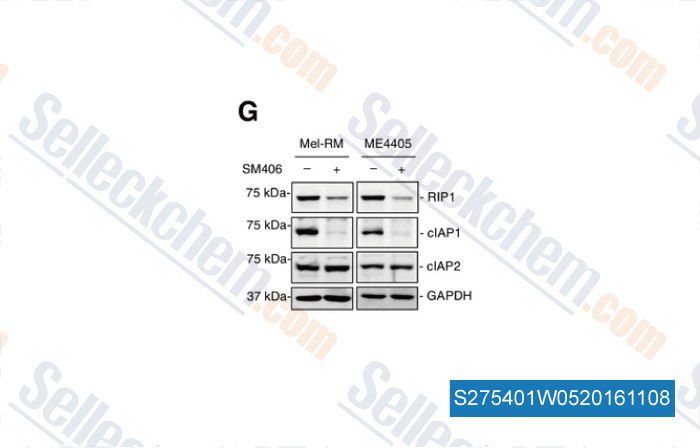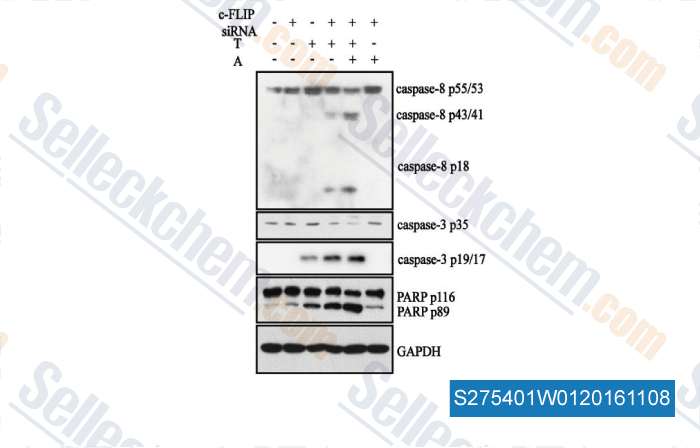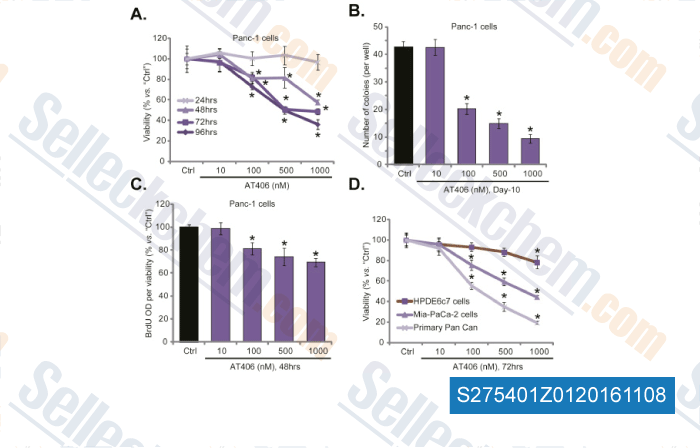|
Toll Free: (877) 796-6397 -- USA and Canada only -- |
Fax: +1-832-582-8590 Orders: +1-832-582-8158 |
Tech Support: +1-832-582-8158 Ext:3 Please provide your Order Number in the email. |
Technical Data
| Formula | C32H43N5O4 |
||||||
| Molecular Weight | 561.71 | CAS No. | 1071992-99-8 | ||||
| Solubility (25°C)* | In vitro | DMSO | 112 mg/mL (199.39 mM) | ||||
| Ethanol | 112 mg/mL (199.39 mM) | ||||||
| Water | Insoluble | ||||||
| In vivo (Add solvents to the product individually and in order) |
|
||||||
|
* <1 mg/ml means slightly soluble or insoluble. * Please note that Selleck tests the solubility of all compounds in-house, and the actual solubility may differ slightly from published values. This is normal and is due to slight batch-to-batch variations. * Room temperature shipping (Stability testing shows this product can be shipped without any cooling measures.) |
|||||||
Preparing Stock Solutions
Biological Activity
| Description | Xevinapant (AT406, ARRY-334543, Debio1143, SM-406) is a potent Smac mimetic and an antagonist of IAP (inhibitor of apoptosis protein via E3 ubiquitin ligase), binding to XIAP-BIR3, cIAP1-BIR3 and cIAP2-BIR3 with Ki of 66.4 nM, 1.9 nM, and 5.1 nM, 50- to 100-fold higher affinities than the Smac AVPI peptide. Phase 1. | ||||||
|---|---|---|---|---|---|---|---|
| Targets |
|
||||||
| In vitro | AT-406 is a Smac mimetic and appears to mimic closely the AVPI peptide in both hydrogen bonding and hydrophobic interactions with XIAP, with additional hydrophobic contacts with W323 of XIAP. AT-406 is more sensitive to these IAPs than Smac AVPI peptide with 50-100 fold binding affinities. AT-406 (at 1 μM) completely restores the activity of caspase-9, which is suppressed by 500 nM XIAP BIR3 in a cell-free system. In MDA-MB-231 cell, AT-406 induces rapid cellular cIAP1 degradation and also pulls down the cellular XIAP protein. AT-406 effectively inhibits lots of human cancer cell lines and shows IC50 of 144 and 142 nM in MDA-MB-231 cell and SK-OV-3 ovarian cell, with low toxicity against normal-like human breast epithelial MCF-12F cells and primary human normal prostate epithelial cells. AT-406 induces apoptosis in MDA-MB-231 cell by inducing activation of caspase-3 and cleavage of PARP. [1] | ||||||
| In vivo | AT-406 has good pharmacokinetic (PK) properties and oral bioavailability in mice, rats, non-human primates, and dogs. In the MDA-MB-231 xenograft, AT-406 effectively induces cIAP1 degradation and processing of procaspase-8, cleavage of PARP in tumor tissues at 100 mg/kg with well toleration even at 200 mg/kg. AT-406 induces significant tumor growth inhibition with p of 0.0012 at 100 mg/kg. [1] |
Protocol (from reference)
| Kinase Assay: |
|
|---|---|
| Cell Assay: |
|
| Animal Study: |
|
References
|
Customer Product Validation

-
, , Cancer Res, 2015, 75(8):1736-48.

-
, , Int J Oncol, 2016, 49(1):153-63.

-
, , Biochem Biophys Res Commun, 2016, 478(1):293-9.

-
Data from [ , , Oncotarget, 2017, 8(6):9466-9475 ]
Selleck's Xevinapant (AT406) Has Been Cited by 41 Publications
| Caspase 9-induced apoptosis enables efficient fetal cell ablation and disease modeling [ Nat Commun, 2025, 16(1):2572] | PubMed: 40089478 |
| The cancer-associated SF3B1K700E spliceosome mutation confers enhanced sensitivity to BV-6-induced cytotoxicity [ Cell Death Dis, 2025, 16(1):476] | PubMed: 40595498 |
| Potentiating CAR-T bystander killing by enhanced Fas/FasL signaling mitigates antigen escape in heterogeneous tumors [ bioRxiv, 2025, 2025.09.22.677496] | PubMed: 41040218 |
| Complex IIa formation and ABC transporters determine sensitivity of OSCC to Smac mimetics [ Cell Death Dis, 2024, 15(11):855] | PubMed: 39578442 |
| Combination Treatment of Resistant Acute Promyelocytic Leukemia Cells with Arsenic Trioxide and Anti-Apoptotic Gene Inhibitors [ Pharmaceuticals (Basel), 2024, 17(11)1529] | PubMed: 39598439 |
| The Effect of Xevinapant Combined with Ionizing Radiation on HNSCC and Normal Tissue Cells and the Impact of Xevinapant on Its Targeted Proteins cIAP1 and XIAP [ Cells, 2023, 12(12)1653] | PubMed: 37371123 |
| The Effect of Xevinapant Combined with Ionizing Radiation on HNSCC and Normal Tissue Cells and the Impact of Xevinapant on Its Targeted Proteins cIAP1 and XIAP [ Cells, 2023, 12(12)1653] | PubMed: 37371123 |
| Mycoplasma hyorhinis infection promotes TNF-α signaling and SMAC mimetic-mediated apoptosis in human prostate cancer [ Heliyon, 2023, 9(10):e20655] | PubMed: 37867861 |
| Mycoplasma hyorhinis infection promotes TNF-α signaling and SMAC mimetic-mediated apoptosis in human prostate cancer [ Heliyon, 2023, 9(10):e20655] | PubMed: 37867861 |
| CD137 (4-1BB) requires physically associated cIAPs for signal transduction and antitumor effects [ Sci Adv, 2023, 9(33):eadf6692] | PubMed: 37595047 |
RETURN POLICY
Selleck Chemical’s Unconditional Return Policy ensures a smooth online shopping experience for our customers. If you are in any way unsatisfied with your purchase, you may return any item(s) within 7 days of receiving it. In the event of product quality issues, either protocol related or product related problems, you may return any item(s) within 365 days from the original purchase date. Please follow the instructions below when returning products.
SHIPPING AND STORAGE
Selleck products are transported at room temperature. If you receive the product at room temperature, please rest assured, the Selleck Quality Inspection Department has conducted experiments to verify that the normal temperature placement of one month will not affect the biological activity of powder products. After collecting, please store the product according to the requirements described in the datasheet. Most Selleck products are stable under the recommended conditions.
NOT FOR HUMAN, VETERINARY DIAGNOSTIC OR THERAPEUTIC USE.
